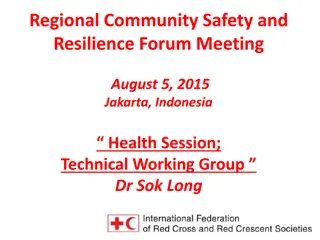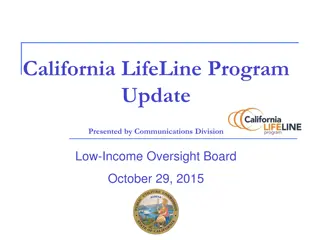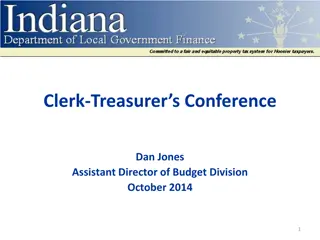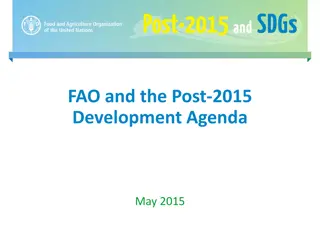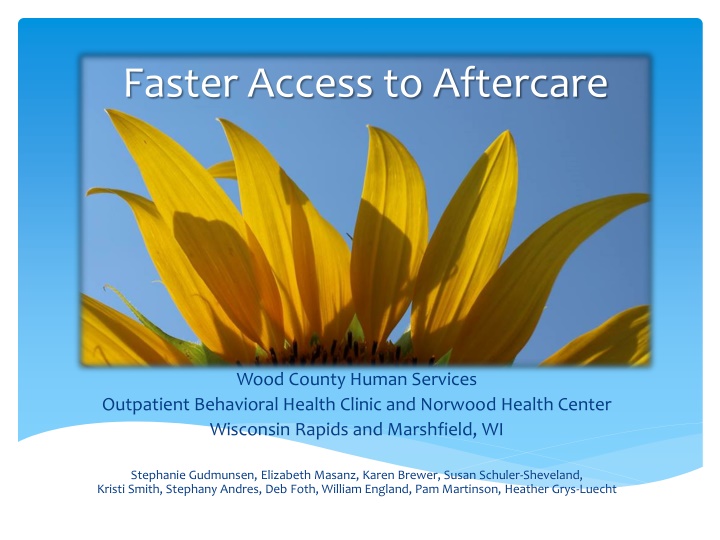
Enhancing Aftercare Services for Wood County Clients
Explore the initiative to improve aftercare services for clients discharged from inpatient care at Wood County Human Services Outpatient Behavioral Health Clinic and Norwood Health Center in Wisconsin Rapids and Marshfield. The project aims to increase follow-up appointment scheduling, reduce post-discharge wait times for care, and enhance client attendance rates for follow-up appointments. Discover the steps taken, changes considered, and the project's growth strategy.
Download Presentation

Please find below an Image/Link to download the presentation.
The content on the website is provided AS IS for your information and personal use only. It may not be sold, licensed, or shared on other websites without obtaining consent from the author. If you encounter any issues during the download, it is possible that the publisher has removed the file from their server.
You are allowed to download the files provided on this website for personal or commercial use, subject to the condition that they are used lawfully. All files are the property of their respective owners.
The content on the website is provided AS IS for your information and personal use only. It may not be sold, licensed, or shared on other websites without obtaining consent from the author.
E N D
Presentation Transcript
Faster Access to Aftercare Wood County Human Services Outpatient Behavioral Health Clinic and Norwood Health Center Wisconsin Rapids and Marshfield, WI Stephanie Gudmunsen, Elizabeth Masanz, Karen Brewer, Susan Schuler-Sheveland, Kristi Smith, Stephany Andres, Deb Foth, William England, Pam Martinson, Heather Grys-Luecht
What are we trying to accomplish? 1. Increase the number of clients that have follow-up appointments scheduled in an outpatient setting within 7 days post discharge from the inpatient psychiatric unit at Norwood Health Center, from an unknown baseline percentage to 100%. 2. Decrease the average number days a client needing follow-up care waits to see a provider (LCSW, LPC, MD, PsyD/PhD) in the outpatient setting of Wood County Human Services, post discharge from Norwood, from 30 days to 7 days or less. 3. Increase the number of clients attending the first scheduled follow-up care appointment with WCHSD, after discharge from NHC from 50% to 75%; with follow-up contact on 100% of clients that no-show for the first appointment.
Steps taken Changes considered Post discharge phone call within 24-hours Time was not protected for staff making calls, so this does not always happen Create communication flow with clinic schedule the walk- in slot vs telling client to go to walk-in clinic Clinic staff not aware to expect patient, therefore no follow-up for no-shows Discontinue Outpatient Clinic Mental-Health Walk-In Clinic Dedicate these two weekly, Wed AM slots to NHC discharges Dedicate two weekly appts the following week from therapist covering walk-in clinic Fast track certain clients to skip intake with therapist and see MD directly in certain circumstances Schedulers to notify social workers if NHC follow-up attend appt or not; SW to follow up with no-shows
How does your project grow? Target Population: Clients discharging from inpatient and seeking aftercare at Wood County for the first time Some of this project work started before formally collecting data Gathered baseline from mid March through mid July 2015 Target population numbers significantly declined mid July through September based on limited numbers, no accurate assessment of trends can be made, but rates for all metrics appear to be holding Metric 3 - 100% follow-up on no-shows has not yet been achieved
Whats next? Continue to gather data Ongoing evaluation of readmission rates and related indirect metrics Put processes in writing to ensure agreement and consistency Continue to evaluate processes to identify gaps and opportunities for improvement
The project to-date Is it good business? We think so, but don t really have the data to prove it Focused target populations can be easier to work with, but if something changes and data becomes limited, it can be difficult to know if changes are really meaningful Communication is key Memories are short, which makes written policies and procedures important






